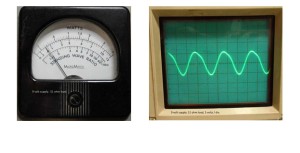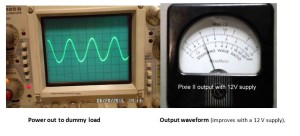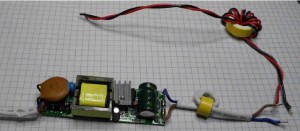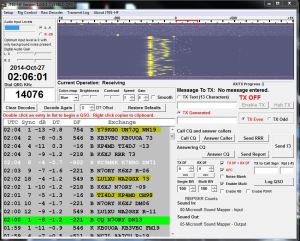- Home
- Registration
- Site Tools
- Articles
- Swap n Shop
- Contesting
- Grounding information for everyone
- History of the Central Alberta Amateur Radio Club
- CAARC owned Repeaters
- Club Repeater Info
- GMT Time Conversion Table
- VE/VA6 Incoming QSL Bureau
- Pine Lake Tornado Friday July 14, 2000.
- Amateur Radio to the Rescue
- CANWARN
- HAM Nation with Bob Heil K9EID
- Net info
- Events.
- ARES
- Links and On line study course.
- Field Day 2019
- Members D/L
- Forum/Swap and Shop
General News

Pixie II v5.1 40 m QRP xcvr Kit by Earl 4Z4TJ
Jul 12th
Pixie II v5.1 40 m QRP xcvr Kit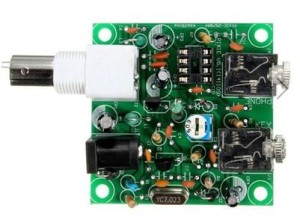
This small kit is a version of the old Pixie II, two transistor, direct-conversion CW “transceiverâ€. Many Pixie IIs were made using Manhattan or dead bug technique. Now a Chinese PCB version is available   on line at such a low price that you will say:
“how can I not build this and try it on the airâ€.
In this application note I will share some of my experiences and suggestions regarding the kit. The first question that occurred to me was: “Is such a simple circuit effective as a communications device?â€Â The answer is yes, but with severe limitations. In any event it is a fun project well worth the money.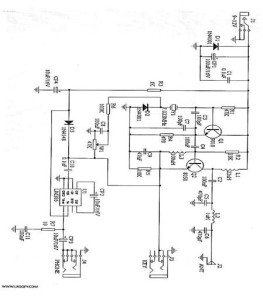
The circuit is simple and mostly self-explanatory. It incorporates some of the later mods developed for the Pixie II. Q1 is a Colpitts crystal oscillator using a reverse biased silicon rectifier as a varicap to pull the crystal frequency the 700 -800 Hz required to give a signal a pleasant tone when in receive mode. This function also gives a small range RIT to clarify signals when listening. The frequency offset is adjusted with W1, the 47K potentiometer.
In transmit Q2 functions as a simple PA with a pi LPF output. This stage buffers the oscillator and increases power to several hundred mW. I measured 250 mW with a 9V supply, 500mW with a 12V supply (see photos). General purpose 2N2222 type transistors are frequently used in Pixie II circuits. I looked up the transistors supplied with the kit and was pleasantly surprised to find the kit manufacturers have gone to the effort of selecting components specific for local oscillator and power amplifier functions.
In receive, Q2 functions as the product detector in a direct conversion receiver with Q1 as the LO and U1 amplifying the detected audio to provide earphone volume. LSB as well as CW signals may be received.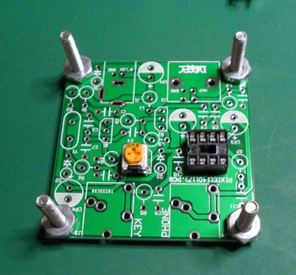
Start construction by inserting 6-32 x ¾†hardware in each of the corner holes. Head of the screw goes on the bottom (solder) side of the PCB. Finger tighten.   These screws act as legs that allow the PCB to rest flat when soldering components. If you plan to mount the PCB in a case this is the time to mark the mounting holes.
Solder the potentiometer and the socket for U1. If you also wish to use this pot as a RIT use wires and a 47 K potentiometer mounted on the “front panelâ€. Next solder the resistors, capacitors (polarity) and diodes (polarity) and inductors in that order. Solder the transistors. Solder the 3 mm stereo sockets the BNC antenna socket and the power socket. I measured all the disc capacitors in the kit and found that they are 20%. The inductors are also 20%. I added a ferrite bead on the lead of L1 to bring the inductance up to the nominal value. L2 was within 10% so I used it. I was not happy about using -20% value capacitors in the LPF so I purchased 1% ceramic capacitors at the local components shop for 15 cents each. It took about two minutes to wind a new 1 mH L2 inductor (15 t) on a T30-2 powdered iron (red) toroid. With the L/C meter attached I spread the windings till the exact value was found. Fix the windings in place with a drop of glue.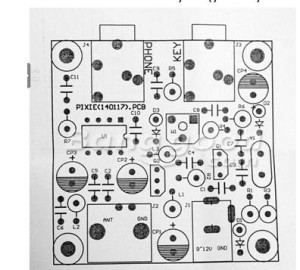
Solder the 7.023 MHz crystal (you may wish to look in your junk box for a crystal that will put you on a QRP calling frequency; 7.030 in EU and 7.040 in North America).
Measure resistance across the power input. Connect the 50 ohm 1 W composition resistor supplied with the kit or other dummy load to the antenna socket.  With a mA meter in series apply 9 – 12 V. Current should be approximately 15 mA. If it is much higher than 15 disconnect power immediately and check your work. (D1 provides reverse polarity protection so a 500 mA fuse might be in order.)  Insert a Morse key in J3. Listen for the oscillator on your station transceiver or connect scope probes across the antenna dummy load 51 ohm 1 W resistor supplied with the kit. 
If the oscillator and PA are working as expected insert U1, connect headphones and a 40m antenna. A 9V – 12 V battery works.
Phone another ham in your city and get him to zero beat your signal and then transmit. Adjust the 47K trim pot for a pleasant tone. You are on the air!
In the evening I connected a 9V battery, Air Canada complementary earphones and my 40m delta loop antenna.   CW stations from EU could be heard and tuned with potentiometer W1.
Now, where did I put that straight key that I used 40 years ago?
CW chirp issues were solved by: 1) Preventing a change in voltage across the varicap, D2, when keying by keeping potentiometer W1 in the middle of its range. 2) Addition of a 22 uF 25V SMT chip capacitor on the bottom of the PCB, across the terminals of the power input socket. To solder one side of the capacitor I scraped away some of the solder mask on the PCB — the other end went tight against the +ve lug of the power socket. (Check for shorts before applying power.)
RF power output with a 12 V supply was found to be 500 mW, as shown at left. In addition, the higher supply voltage yields a waveform appearing closer to a clean sine wave, (photos above) generating fewer harmonics.
Note: LPF: I checked for 2nd and 3rd harmonics and they are easy to find within the shack. I believe that higher quality components in the LPF will reduce harmonic radiation. However, another ham in the same city could not hear the second harmonic (this is my spectrum analyzer equivalent test).  So, even with sub-optimum suppression, the second harmonic will be at a level of approximately 0 dbm – not a level that will wreak QRM havoc on 20m and 15m CW (second and third harmonics).
On the air results.
Hams within a 200 Km radius could hear the QRP CW signal. After correcting the chirp issue reports were good. Surprisingly the direct conversion receiver also let me hear them easily, so 2 way QSOs are definitely possible. Listening on 40m just after dark let me hear most of the 40m CW band – all at once. Stations could be peaked by adjusting the 47K trim pot. Where a few individual CW signals could be identified I found them on my FT-450 – surprisingly they were not S9+ signals but pretty ordinary S7 signals, indicating that the direct conversion receiver is quite sensitive. Good sensitivity combined with poor selectivity effectively restricts 2-way communications use to daylight hours. In spite of the receive limitation, it is pretty amazing that two way communications are possible with such simple, low cost equipment.
Conclusion
Lots of fun for the money!
To download this original article click this link

AD9850 DDS VFO By Earl Rubin 4Z4TJ
Jun 5th
AD9850 DDS VFO
Earl Rubin 4Z4TJ
While shopping on line I came across a AD9850 DDS Signal Generator Module (http://www.banggood.com/AD9850-DDS-Signal-Generator-Module-0-40MHz-IC-Test-Equipment-p-915819.html ) and, of course had to have it. After it arrived I started to look at the possible applications and came across Richard’s website: http://www.ad7c.com/projects/ad9850-dds-vfo/ . I believe that this is a good module to work with because they are widely available on eBay at low price, there are many on line descriptions, you-tube videos and other information….Please click the following link for the full article

Easy prototyping of PCB boards By Earl Rubin 4Z4TJ
Jun 5th
Easy prototyping of PCB boards
Looking for a way to easily make “Manhattan†style PCB breadboards I re-discovered the “Islander†– see reference 2 below, but was unsuccessful in finding a way to purchase one. Then I found Andy Davies’ You-Tube video describing his home made land cutter. Not wanting to wait for a ¼†drill bit to break of its own accord, I sacrificed the dullest 7 mm bit in my drill box.
First I clamped the bit horizontally into…Please click the following blue link for the complete article
Easy prototyping of PCB boards

RFI considerations when converting to LED lighting By Earl Rubin 4Z4TJ
Jun 5th
RFI considerations when converting to LED lighting
By Earl Rubin, VA6TJ
I installed my new LED ceiling fixture in my shack. The light fixture consists of a flat panel of LEDs mounted in an aluminum frame that also contains a small switching power supply.. Â Before installing the new light fixture I thought it might be a good idea to check RFI on HF….
Please click the blue link below to download the complete article
WANTED
Mar 9th
WANTED 4-400 LINEAR AMP TUBE(S)FOR MY HOME BREW GROUNDED GRID LINEAR
DOUG BRADLEY VE6VY
CAARC on facebook
Dec 28th
Joint the site for information and sharing.
https://www.facebook.com/groups/117167868317864/
NEW CAARC Executive for 2014-2015
Nov 28th
The Annual General meeting of CAARC was held on Tuesday November 18th at the new Red Deer County Search and Rescue building. Ric Henderson VA6RIC ( Director of Community and Protective Services) gave everyone a tour of the new facility and equipment.
The new executive for the 2014-2015 year is as listed below.
Thanks to everyone who attended and congratulations to the new executive.
I look forward to working with you over the next year.
Bob VE6BLD
Past President – Sandy Jacobs VE6SND
President– Bob King VE6BLD
Vice President-Â Steven Lee VA6SGL
Secretary– Bill Jackson VA6BLL
Treasurer– Karen McKinney VA6LDY
Directors
- Brian Davies VE6CKC
- Neil Rowe VA6AK
- Rick Koinberg VE6RAK
- Bob Bryce VA6TRB
- Bryan McKay VE6JPW
Appointments
Repeaters
Skip MacAulay VE6BGT
Emergency Coordinator
Jeff Low VA6JL
Publicity
Geoff Norris VA6TAC
Webmaster
Bob King VE6BLD
Net Control
Bob King VE6BLD

